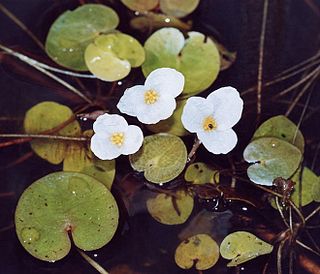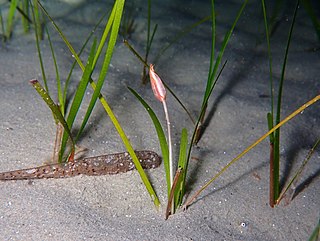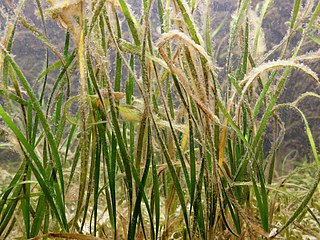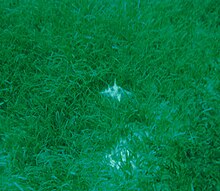
Seagrasses are the only flowering plants which grow in marine environments. There are about 60 species of fully marine seagrasses which belong to four families, all in the order Alismatales. Seagrasses evolved from terrestrial plants which recolonised the ocean 70 to 100 million years ago.

Hydrocharitaceae is a flowering plant family including 16 known genera with a total of ca 135 known species, that including a number of species of aquatic plant, for instance the tape-grasses, the well known Canadian waterweed, and frogbit.

A seagrass meadow or seagrass bed is an underwater ecosystem formed by seagrasses. Seagrasses are marine (saltwater) plants found in shallow coastal waters and in the brackish waters of estuaries. Seagrasses are flowering plants with stems and long green, grass-like leaves. They produce seeds and pollen and have roots and rhizomes which anchor them in seafloor sand.

Cymodoceaceae is a family of flowering plants, sometimes known as the "manatee-grass family", which includes only marine species.

Phyllospadix scouleri, or Scouler's surfgrass, is a flowering marine plant in the family Zosteraceae. It is native to the coastline of western North America from the Alaskan panhandle to Baja California.

Halophila johnsonii, or Johnson's seagrass, is a small, asexual seagrass in the family Hydrocharitaceae. It occurs only on the southeastern coast of Florida, and was the first marine plant listed on the United States endangered species list, though it was removed from listing in April 2022. Female flowers have been observed, but even with decade long observational studies, neither male flowers nor seed have ever been observed.
The Seagrasses of Western Australia are submerged flowering plants found along the coast, around islands, and in Estuaries of Western Australia. The region contains some of the largest seagrass meadows in the world, and is the most diverse in the number of species. The variety of habitats along its western and southern coasts is often soft sands in shallow subtropical waters, ideal for these plants.

Enhalus is a monotypic genus of marine flowering plants. The sole species is Enhalus acoroides. Enhalus is a large seagrass native to coastal waters of the tropical Indian and Western Pacific Oceans. It is the only species of seagrass that does aerial surface pollination in which the pollen and the styles remain dry. Enhalus is surface pollinated with male flowers that detach from the plant to float on the surface until they reach a female flower where pollination can occur. Enhalus acoroides is considered a slow-growing, "climax" species.

Thalassia is a marine seagrass genus comprising two known species.

Colombier, Saint Barthélemy is a quartier of Saint Barthélemy in the Caribbean. It is located in the northwestern part of the island.

Cymodocea nodosa is a species of seagrass in the family Cymodoceaceae and is sometimes known as little Neptune grass. As a seagrass, it is restricted to growing underwater and is found in shallow parts of the Mediterranean Sea and certain adjoining areas of the Atlantic Ocean.

Halophila engelmannii is a species of seagrass in the Hydrocharitaceae family. It is referred to by the common names star grass and Engelmann's seagrass and grows underwater on shallow sandy or muddy sea floors. It is native to the Bahamas, the Cayman Islands, Costa Rica, Cuba, the Gulf Coast of the United States, the Gulf Coast of Mexico, Puerto Rico, and Trinidad and Tobago.

Halophila decipiens, commonly known as Caribbean seagrass or paddle grass, is a seagrass in the family Hydrocharitaceae. It grows underwater on sandy or muddy sea floors in shallow parts of tropical seas.

Halodule wrightii is an aquatic plant in the Cymodoceaceae family. It is referred to by the common names shoal grass or shoalweed, and is a plant species native to seacoasts of some of the warmer oceans of the world.

Zostera noltii is a species of seagrass known by the common name dwarf eelgrass. It is found in shallow coastal waters in north western Europe, the Mediterranean Sea, Black Sea, Caspian Sea and Aral Sea and on islands in the Atlantic off the coast of northwest Africa. It is an important part of the intertidal and shallow subtidal ecosystems of estuaries, bays and lagoons.

Halodule uninervis is a species of seagrass in the family Cymodoceaceae. It is native to the western Pacific and Indian Oceans. Common names include narrowleaf seagrass in English and a'shab bahriya in Arabic.
Lobophora variegata is a species of small thalloid brown alga which grows intertidally or in shallow water in tropical and warm temperate seas. It has three basic forms, being sometimes ruffled, sometimes reclining and sometimes encrusting, and each form is typically found in a different habitat. This seaweed occurs worldwide. It is the type species of the genus Lobophora, the type locality being the Antilles in the West Indies.
Zostera novazelandica Setchell is a species of seagrass in the family Zosteraceae found on the shores of New Zealand. It is regarded as a distinct species by some authors but considered as a synonym of Zostera muelleri Irmisch ex Ascherson by others. The Maori names for Zostera novazelandica are karepō, nana, rehia, and rimurehia.

Zostera muelleri is a southern hemisphere temperate species of seagrass native to the seacoasts of South Australia, Victoria and Tasmania. and New Zealand. Today, Zostera muelleri can be found in regions of Australia, New Zealand, and Papua New Guinea, as well as areas of the eastern Indian Ocean, and the southwest and western central Pacific Ocean. Zostera muelleri is a marine angiosperm, and is commonly referred to as eelgrass or garweed. It is a fast growing and readily colonizing species that serves as a feeding ground for wading birds and aquatic animals, and a breeding ground for juvenile fish and shrimp species.
Halophila baillonis is a species of aquatic plant in the family Hydrocharitaceae. It is referred to by the common name clover grass. It is native to Brazil, Cayman Islands, Colombia, Costa Rica, Jamaica, Leeward Islands, Netherlands Antilles, Panama, Puerto Rico, Trinidad and Tobago, and Venezuela. It is listed on the IUCN Red List as "vulnerable" due to its naturally rare occurrence and fragmented populations.



















